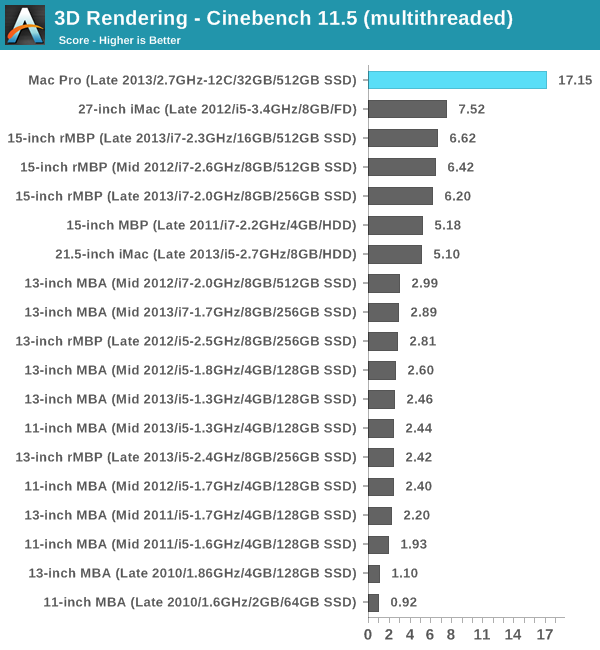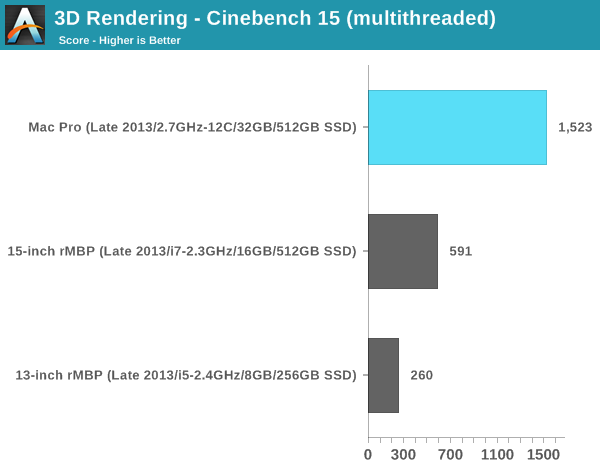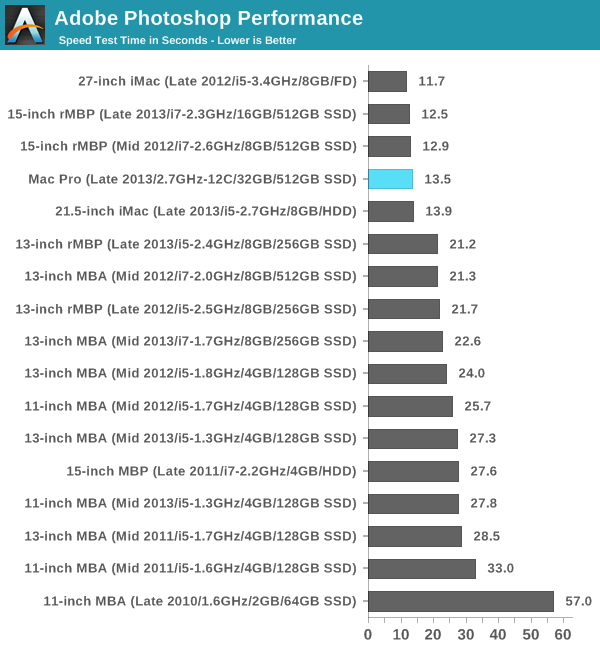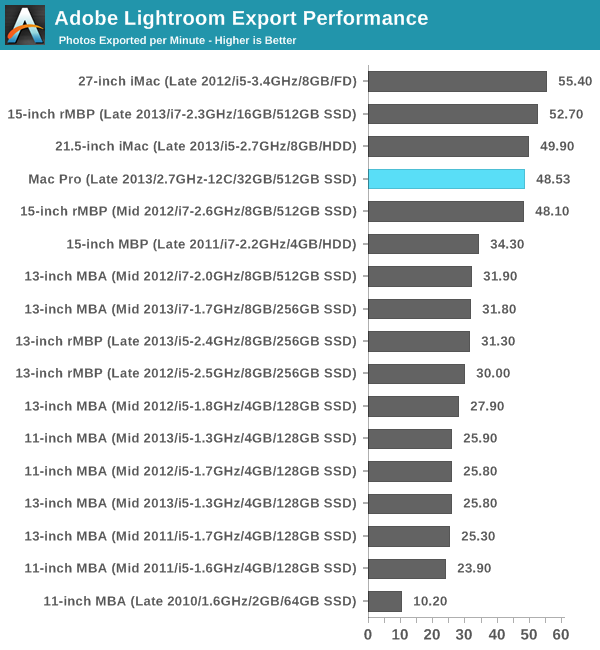The Mac Pro Review (Late 2013)
by Anand Lal Shimpi on December 31, 2013 3:18 PM ESTMac Pro vs. Consumer Macs
For my final set of CPU performance charts I put the new Mac Pro through the same set of tests I do all new Macs. There are definitely multithreaded components to these tests (some are indeed highly threaded), but the suite also values good single threaded performance. Here we'll get an idea of how the new Mac Pro, in its most expensive configuration, fares as a normal Mac.
I've already gone through Cinebench 11.5 results, but the following graphs should put in perspective the Mac Pro's performance relative to all consumer Macs:

If there's one graph that tells the story of why Intel's workstation roadmap is ridiculous, it's this one. The Mac Pro follows Intel's workstation roadmap, which ends up being cut down versions of Intel's server silicon, which happens to be a generation behind what you can get on the desktop. So while the latest iMac and MacBook Pro ship with Intel's latest Haswell cores, the Mac Pro uses what those machines had a year ago: Ivy Bridge. Granted everything else around the CPU cores is beefed up (there's more cache, many more PCIe lanes, etc...), but single threaded performance does suffer as a result.
Now part of this is exaggerated by the fact that I'm reviewing the 2.7GHz 12-core Mac Pro configuration. Single core turbo tops out at 3.5GHz vs. 3.9GHz for the rest of the parts. I suspect if you had one of the 8-core models you'd see peak single threaded performance similar to what the 2012 27-inch iMac delivers. The 2013 27-inch iMac with its fastest CPU should still be quicker though. We're not talking about huge margins of victory here, a matter of a handful of percent, but as a much more expensive machine it's frustrating to not see huge performance leadership in all areas.
The Mac Pro is designed to offer competitive single threaded performance, but really deliver for everyone who depends on great multithreaded performance:

If you need more cores, the Mac Pro is literally the only solution Apple offers that can deliver. We're talking about multiple times the performance offered by anything else in Apple's lineup with a Pro suffix.
I'm slowly but surely amassing Cinebench 15 results. The story doesn't really change here, I just thought I'd publish the numbers in case anyone wants data using this new test:


The latest versions of iPhoto and iMovie break comparisons to my older benchmarks so I've had to drop them here. I still have our Photoshop CS5 and Lightroom 3 tests though:

As I mentioned earlier, threading seems to have improved on newer versions of Photoshop. In CS5 our benchmark looks more like a lightly threaded test by comparison. Out of curiosity I ran the test under Photoshop CS6 and came away with a completion time of around 6 seconds.

Our Lightroom 3 export test tells a very similar story. Anyone with lighter workloads looking for a huge performance increase thanks to the Mac Pro will have to look elsewhere. The Mac Pro is at least performance competitive, but in these lightly threaded workloads you won't see a huge uplift.










267 Comments
View All Comments
zepi - Wednesday, January 1, 2014 - link
How about virtualization and for example VT-d support with multiple gpu's and thunderbolts etc?Ie. Running windows in a virtual machine with half a dozen cores + another GPU while using rest for the OSX simultaneously?
I'd assume some people would benefit of having both OSX and Windows content creation applications and development environments available to them at the same time. Not to mention gaming in a virtual machine with dedicated GPU instead of virtual machine overhead / incompatibility etc.
japtor - Wednesday, January 1, 2014 - link
This is something I've wondered about too, for a while now really. I'm kinda iffy on this stuff, but last I checked (admittedly quite a while back) OS X wouldn't work as the hypervisor and/or didn't have whatever necessary VT-d support. I've heard of people using some other OS as the hypervisor with OS X and Windows VMs, but then I think you'd be stuck with hard resource allocation in that case (without restarting at least). Fine if you're using both all the time but a waste of resources if you predominantly use one vs the other.horuss - Thursday, January 2, 2014 - link
Anyway, I still would like to see some virtualization benchs. In my case, I can pretty much make it as an ideal home server with external storage while taking advantage of the incredible horse power to run multiple vms for my tests, for development, gaming and everything else!iwod - Wednesday, January 1, 2014 - link
I have been how likely we get a Mac ( Non Pro ) Spec.Nvidia has realize those extra die space wasted for GPGPU wasn't worth it. Afterall their main target are gamers and gaming benchmarks. So they decided for Kepler they have two line, one for GPGPU and one on the mainstream. Unless they change course again I think Maxwell will very likely follow the same route. AMD are little difference since they are betting on their OpenCL Fusion with their APU, therefore GPGPU are critical for them.
That could means Apple diverge their product line with Nvidia on the non Professional Mac like iMac and Macbook Pro ( Urg.. ) while continue using AMD FirePro on the Mac Pro Line.
Last time it was rumoured Intel wasn't so interested in getting a Broadwell out for Desktop, the 14nm die shrink of Haswell. Mostly because Mobile / Notebook CPU has over taken Desktop and will continue to do so. It is much more important to cater for the biggest market. Not to mention die shrink nowadays are much more about Power savings then Performance Improvements. So Intel could milk the Desktop and Server Market while continue to lead in Mobile and try to catch up with 14nm Atom SoC.
If that is true, the rumor of Haswell-Refresh on Desktop could mean Intel is no longer delaying Server Product by a single cycle. They will be doing the same for Desktop as well.
That means there could be a Mac Pro with Haswell-EP along with Mac with a Haswell-Refresh.
And by using Nvidia Gfx instead of AMD Apple dont need to worry about Mac eating into Mac Pro Market. And there could be less cost involve with not using a Pro Gfx card, only have 3 TB display, etc.
words of peace - Wednesday, January 1, 2014 - link
I keep thinking that if the MP is a good seller, maybe Apple could enlarge the unit so it contains a four sided heatsink, this could allow for dual CPU.Olivier_G - Wednesday, January 1, 2014 - link
Hi,I don't understand the comment about the lack of HiDPI mode here?
I would think it's simply the last one down the list, listed as 1920x1080 HiDPI, it does make the screen be perceived as such for apps, yet photos and text render at 4x resolution, which is what we're looking for i believe?
i tried such mode on my iMac out of curiosity and while 1280x720 is a bit ridiculously small it allowed me to confirm it does work since OSX mavericks. So I do expect the same behaviour to use my 4K monitor correctly with mac pro?
Am I wrong?
Gigaplex - Wednesday, January 1, 2014 - link
The article clearly states that it worked at 1920 HiDPI but the lack of higher resolutions in HiDPI mode is the problem.Olivier_G - Wednesday, January 1, 2014 - link
Well no it does not state that at all I read again and he did not mention trying the last option in the selector.LumaForge - Wednesday, January 1, 2014 - link
Anand,Firstly, thank you very much for such a well researched and well thought out piece of analysis - extremely insightful. I've been testing a 6 core and 12 core nMP all week using real-life post-production workflows and your scientific analysis helps explain why I've gotten good and OK results in some situations and not always seen the kinds of real-life improvements I was expecting in others.
Three follow up questions if I may:
1) DaVinci Resolve 10.1 ... have you done any benchmarking on Resolve with 4K files? ... like FCP X 10.1, BMD have optimized Resolve 10.1 to take full advantage of split CPU and GPU architecture but I'm not seeing the same performance gains as with FCP x 10.1 .... wondering if you have any ideas on system optimization or the sweet spot? I'm still waiting for my 8 core to arrive and that may be the machine that really takes advantage of the processor speed versus cores trade-off you identify.
2) Thunderbolt 2 storage options? ... external storage I/O also plays a significant role in overall sustained processing performance especially with 4K workflows ... I posted a short article on Creative Cow SAN section detailing some of my findings (no where as detailed or scientific as your approach I'm afraid) ... be interested to know your recommendations on Tbolt2 storage.
http://forums.creativecow.net/readpost/197/859961
3) IP over Tbolt2 as peer-to-peer networking topology? ... as well as running the nMPs in DAS, NAS and SAN modes I've also been testing IP over Tbolt2 .... only been getting around 500 MB/s sustained throughput between two nMPs ... if you look at the AJA diskwhack tests I posted on Creative Cow you'll see that the READ speeds are very choppy ... looks like a read-ahead caching issue somewhere in the pipeline or lack of 'Jumbo Frames' across the network ... have you played with TCP/IP over Thunderbolt2 yet and come to any conclusions on how to optimize throughput?
Keep up the good work and all the best for 2014.
Cheers,
Neil
modeleste - Wednesday, January 1, 2014 - link
I noticed that the Toshiba 65" 4k TV is about the same price as the Sharp 32" The reviews seem nice.Does anyone have any ide what the issues would be with using this display?